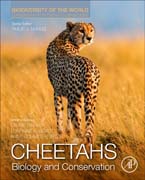
Cheetahs: Biodiversity of the World: Conservation from Genes to Landscapes
Nyhus, Philip J.
Marker, Laurie
Boast, Lorraine K.
Schmidt-Kuentzel, Anne
Cheetahs: Biodiversity of the World: Conservation from Genes to Landscapes reports on the science and conservation of the cheetah both in situ and ex situ, covering such aspects of cheetah biology and ecology as demography, density and feeding behavior; genetic makeup and disease risks; and home range requirements and spatial utilization. The volume includes a broad range of topics, demonstrating the interdisciplinary nature of research and conservation efforts. The book begins with chapters on the unique physiology of this species, followed by the taxonomy and genetic status of the cheetah, leading into their behavior and ecology. The book features contributions on the current and evolving threats to the species, which include habitat loss, declining prey base, human-wildlife conflict with livestock, illegal trade and newly-emerging threats, notably climate change. Cheetahs have been studied through physical examination, laboratory analysis, radio-tracking and human perceptions. Considerable progress has been made in developing strategies to improve their status, including changing farmers' attitudes and other efforts that have resulted in greater tolerance for the cheetah. Status reports from around the regions are included as well as a better understanding of how international conventions (CITES, CMS, etc.), and the IUCN Cat Specialist Group have assisted in conservation planning. A section on conservation strategies begins with an overview of the similarities and challenges rural livestock farming communities play in assuring the cheetah's long-term survival, and continues by including several case studies of successful conservation programs in various countries throughout the cheetah's range. Chapters on the long-term research and role of captive cheetahs to conservation of the species are included, such as disease studies and reproductive strategies by North American and European experts on the subjects. Features contributions edited and written by the world's leading cheetah researchers and practitioners, focused on this high-profile species of conservation concernPresents the latest in cheetah research and conservation efforts globally, furthering range-wide conservation plans for the cheetah both in the wild and in captivityIncludes contributions from a variety of disciplinary and scale perspectives, ranging from genetics/evolution and ecology to behavior, toxicology, large landscape conservation, conflict and policyHelps lay a foundation for the cheetah community worldwide by assembling and making available current knowledge of the species not only to cheetah researchers and conservationists, but to policy makers, business leaders, zoo managers, academics and students INDICE: Section 1 1. A retrospective history of cheetah research and conservation efforts 2. History of the cheetah-human relationship 3. Evolutionary history and paleoecology 4. Current status and distribution overview 5. Asiatic cheetahs in iran: decline, current status and threats 6. The cheetahs' genetic history 7. Cheetah specialization - physiology and morphology 8. Ecology of free-ranging cheetah 9. Cheetah behaviour 10. Habitat loss and fragmentation 11. The status of key prey species and the consequences of prey loss for cheetah conservation 12. Climate warming: the consummate threat to cheetah survival 13. The impacts and drivers of human-cheetah conflict on livestock and game farms 14. Pets and pelts: understanding and combating illegal trade in cheetahs 15. Use of livestock guarding dogs to reduce human-cheetah conflict 16. Improved and alternative livelihoods: the link between poverty alleviation and biodiversity conservation 17. Coordination of large landscapes for cheetah conservation 18. Cheetah conservation and educational programs 19. Protection in protected areas 20. Cheetah translocation and reintroduction programs: the past, present and future 21. Global cheetah conservation policy: a review of international law and enforcement 22. History and current status of cheetahs in zoos 23. Why keep cheetahs in zoos? - an integrative approach for cheetah conservation 24. Clinical management of Cheetahs 25. History and current status of cheetah diseases and captive health 26. Nutritional considerations for captive cheetahs 27. Reproductive physiology of the cheetah and assisted reproductive techniques 28. Communicating the conservation message-using ambassador cheetahs in education 29. The use of remote camera trapping to study cheetahs 30. Spoor tracking to monitor cheetah populations 31. Mining black gold - finding, analysing and genetic insights from cheetah scat 32. Field methods for visual and remote monitoring of cheetah 33. Spatial and landscape analyses 34. Capture, care and collaring of free ranging cheetahs 35. Social science methods to study human-cheetah coexistence 36. Citizen science in cheetah research 37. PVA modelling 38. Now you see them, soon you won't: statistical and mathematical models for cheetah conservation management 39. Future directions in cheetah survival - in light of growing threats, new tools and conservation successes
- ISBN: 978-0-12-804088-1
- Editorial: Academic Press
- Encuadernacion: Cartoné
- Páginas: 516
- Fecha Publicación: 01/11/2017
- Nº Volúmenes: 1
- Idioma: Inglés
